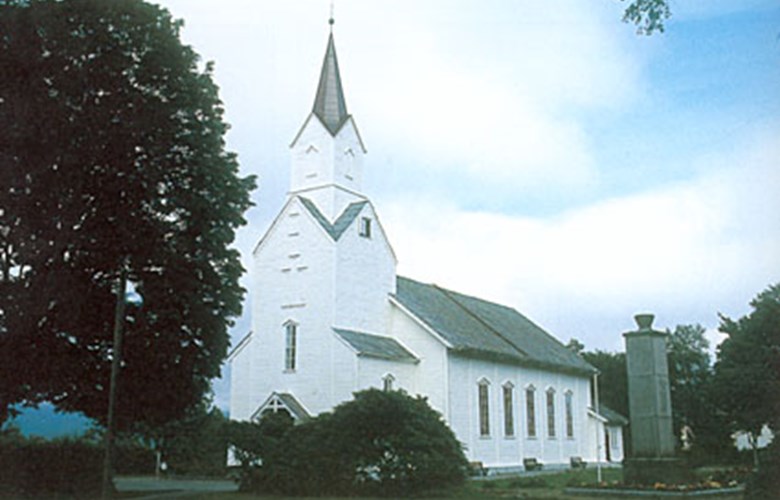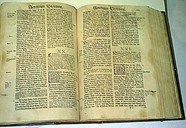City without a church
For the first 22 years after Florø was granted city privileges, it was probably the only city in the country without a church of its own. The city people had to undertake the exhausting voyage to the old church at Kinn to be able to attend church services. For obvious reasons, the church issue was a recurrent topic in the Florø city council after 1860.
Already in the first city plan a site had been designated for the church, but for various reasons, the matter was left unresolved. In the first place, the economy was suffering because of the failing herring fisheries, secondly, there was disagreement between the city of Florø and the municipality as to the financing of the church, and finally, there was an internal disagreement as to the location of the church. For a while suggestions were even put forward to build a new church at Brandsøy, seven kilometers (about five miles) east of the city instead of building a new church both at Stavang and in Florø.
Built near the vicarage
Florø church was built a short distance up from the sea, at the end of the (present) ¿Kyrkjegata" (Church Street) on what was still undeveloped land in 1882. At a later stage, ¿Hans Blomgata" was built as a parallel street to "Strandgata", and the church was then situated at the end of this street. Hans Blom - a vicar and a member of Parliament - was an ardent spokesman for the founding of a city on Florelandet. The church was built according to the model of Helgheim church in Jølster, at a cost of 21 530 kroner. Some details were decided as the church was being built. As late as in June, 1882, only a few months before the church was completed, the city council opted for a square steeple instead of a round one.
The congregation and the vicars were pleased that the city had finally got its own church. Ever since the 16th century, vicars had complained about the harsh weather conditions on the island of Kinn, and the situation was not significantly better on the island of Skorpa, where the vicarage was located between 1560 and 1755. One vicar had the good foresight to take the matter in his own hands, as it were, and moved the vicarage to the mainland of Florelandet, a mere 500 meters (about 600 yards) from the site where the church was built in 1882.
At first the graveyard was located to the south and west of the church, but already in the late 19th century, it turned out that there was a shortage of space, and a new graveyard was established at Myrane, about a kilometre from the church. Today the old graveyard has been turned into a park with a fountain and a memorial for the war victims from the municipality of Flora.
The church building
Florø church is a big church built in a pure style with a high nave. On either side wall there are five big windows with pointed gables. The chancel is pentagonal with three big windows. All the stained-glass windows are framed in lead. There are two vestries, one for the vicar and one reserved for babies to be christened. On the large gallery much of the space is occupied by a new organ. The church also had an organ for the consecration ceremony in 1882, and this was one of the first organs in the region of Sunnfjord.
The colours in the church are in various shades of grey, repainted in 1999. At the same time the pews were repaired and fitted with cushions. Two rows of pews at the back of the nave have been removed to make space for various exhibits, and also to provide a meeting place for ¿church coffee" functions. There were no stoves when the church was new, but they were installed five years later in 1887. Only in 1965 did the church get electric heating.
The altarpiece
The altarpiece form 1882 is a copy of Bertel Thorvaldsen¿s famous Christ sculpture, placed behind and on the altar. Copies of Thorvaldsen¿s sculpture are used as an altarpiece in a number of churches in this country, and in this county in Eikefjord and Gimmestad. Copies on a smaller scale were also popular and some version of his Christ sculpture is found in many homes around the country.
The Danish sculptor Bertel Thorvaldsen (1770-1844) at first wanted to portray the victorious Christ with lifted arms, but chose instead to show Christ welcoming publicans and sinners. The open and including position of the arms is significant.
Art and interior
There are two candlesticks on the altar. The Holy Communion objects consist of a chalice and a dish in silver dating from 1882, and a pyx and a wine cruet. Frederik II¿s bible from 1588 has been donated by Andreas and Lovise Hjertenes.
The pulpit and the font both date from 1882. The baptismal bowl is also from 1882, and the holy water ewer from 1960. The votive ship model was made by Ragnar Kristiansen in 1997.
The organ dates from 1982 and has 30 registers, and, in addition, there is an organ positive from 1979 with five registers, both made by Jehmlich.
There are two church bells, both made in Bochum, Germany in 1882. One carries the inscription "Gloria Dei" and the other "Kinn kirke 1882".






